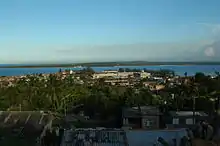Gibara
Gibara (Spanish pronunciation: [xiˈβaɾa]) is a town and municipality of the Province of Holguín in the Republic of Cuba. Gibara is the fourth largest town by population and the ninth by area in Holguín.
Gibara | |
|---|---|
 | |
 Coat of arms | |
| Nickname(s): La Villa Blanca de los Cangrejos | |
.png.webp) Gibara municipality (red) within Holguín Province (yellow) and Cuba | |
| Coordinates: 21°06′26″N 76°08′12″W | |
| Country | Cuba |
| Province | Holguín |
| Established | 1817[1] |
| Area | |
| • Total | 630 km2 (240 sq mi) |
| Elevation | 45 m (148 ft) |
| Population (2004)[3] | |
| • Total | 72,810 |
| • Density | 115.6/km2 (299/sq mi) |
| Time zone | UTC-5 (EST) |
| Area code(s) | +53-24 |
History

The main town was founded on January 16, 1817. It is also known as "The White Town", Spanish: La Villa Blanca. Gibara has a beautiful and breezy landscape, and also possesses excellent architectural designs and a well-planned layout of its streets, houses and parks. Even so, Gibara's biggest asset, according to visitors, are its people, which are described as cooperative, friendly, affectionate, and proud of their village and of its history. It is said Admiral Christopher Columbus had remarked of Gibara's environs that “it is the most beautiful land that human eyes saw.”
"The White Villa" in Gibara, although small, is said to possess a peculiar charm, exhibiting an architectural patrimony reflecting almost two centuries of history, as well as its people's cultural roots. Currently, some controversy exists about whether it was the Bay of Gibara or the Bay of Bariay that Columbus' ships reached during his first voyage to Cuba. The island of Cuba was discovered on October 28, 1492 after the disembarkation of La Pinta, La Niña and La Santa María, the first three European ships under the command of Columbus during his first trip toward the New World.
Gibara was declared a National Monument in 2002; additionally, since 2003, the International Festival of Cinema, where films are presented in a number of different categories, has been held in this small coastal town.
Demographics
In 2004, the municipality of Gibara had a population of 72,810.[3] With a total area of 630 km2 (240 sq mi),[2] it has a population density of 115.6/km2 (299/sq mi).
The municipality is divided into the barrios of Arroyo Blanco, Blanquizal, Bocas, Candelaria, Cantimplora, Cupeycillos, Palmita, Rabón.[1]
References
- Guije.com. "Gibara" (in Spanish). Retrieved 2007-10-05. - the list of barrios in the article does not match the source, which refers to 1943 when the municipality was 1.5 times the size
- Statoids. "Municipios of Cuba". Retrieved 2007-10-05.
- Atenas.cu (2004). "2004 Population trends, by Province and Municipality" (in Spanish). Archived from the original on 2006-07-14. Retrieved 2007-10-05.
![]() This article incorporates text from a publication now in the public domain: Chisholm, Hugh, ed. (1911). "Gibara". Encyclopædia Britannica. 11 (11th ed.). Cambridge University Press. p. 927.
This article incorporates text from a publication now in the public domain: Chisholm, Hugh, ed. (1911). "Gibara". Encyclopædia Britannica. 11 (11th ed.). Cambridge University Press. p. 927.
External links
![]() Media related to Gibara at Wikimedia Commons
Media related to Gibara at Wikimedia Commons
